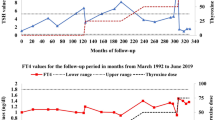Abstract
Of the 37 families with TBG deficiency so far described, 31 were shown to be compatible with X chromosome linked mode of inheritance, and in 5 of the remaining 6 this mode of transmission was suspected. Difficulties in proving X chromosome linkage in some families was usually due to the inability to identify the heterozygous female carriers when affected males were only partially TBG deficient. This work describes a new family with inherited TBG deficiency which on first glance showed inconsistencies with X chromosome linked inheritance. More specifically, there was an apparent male to male transmission of the trait and the presentation in one female of low TBG, phenotypically indistinguishable from the affected males. Studies on three generations identified TBG deficiency on both the maternal and paternal branches of the family. We were thus able to prove that the affected male inherited the trait from his heterozygous mother, rather than from his father, and that the female with more severe TBG deficiency was homozygous for the trait through acquisition of a defective X chromosome from both mother and father. The latter explained her phenotype presentation indistinguishable from that in affected hemizygous males. Thus, unless proven otherwise, all inherited TBG abnormalities in man appear to be X chromosome linked. Because of the relatively common prevalence of inherited TBG defects, marriages among such individuals are expected to give rise to a progeny with an unusual phenotypic presentation. All members of the family were clinically euthyroid and affected members showed a normal TSH response to TRH.
Similar content being viewed by others
References
Marshall J.S., Levy R.P., Steinberg A.G. Human thyroxine-binding globulin deficiency: A genetic study. N. Engl. J. Med. 274: 1469, 1966.
Nikolai T.F., Seal U.S. X-chromosome linked familial decrease in thyroxine-binding globulin activity. J. Clin. Endocrinol. Metab. 25: 835, 1966.
Nikolai T.F., Seal U.S. X-chromosome linked inheritance of thyroxine-binding globulin deficiency. J. Clin. Endocrinol. Metab. 27: 1515, 1967.
AvRuskin T.W., Braverman L.E., Crigler J.F. Jr. Thyroxine-binding globulin deficiency and associated neurological deficit. Pediatrics 50: 638, 1972.
Bode H.H., Rothman K.J., Danon M. Linkage of thyroxine-binding globulin deficiency to other X-chromosome loci. J. Clin. Endocrinol. Metab. 37: 25, 1973.
Grant D.B., Minchin-Clarke H.G., Putman D. Familial thyroxine-binding globulin deficiency: Search for linkage with Xg blood groups. J. Med. Genet. 11: 271, 1974.
Wallace E.Z., Kapoor S., Veleanu M. Study of a kindred with thyroxine-binding globulin deficiency and oligomenorrhea. Am. J. Obstet. Gynecol. 122: 79, 1975.
Niimi H., Sasaki N. Familial thyroxine-binding globulin deficiency in a patient with congenital hypothyroidism. Endocrinol. Jpn. 22: 35, 1975.
Nicoloff J.T., Dowling J.T., Patton D.D. Inheritance of decreased thyroxine-binding by the thyroxine-binding globulin. J. Clin. Endocrinol. Metab. 24: 294, 1964.
Roberts R.C., Nikolai T.F., Lohrenz F.N. A TBG-deficient family with, a male exhibiting decreased but not zero TBG levels. J. Clin. Endocrinol. Metab. 30: 131, 1970.
Heinonen O.P., Lamberg B.A., Virtamo J. Inherited decrease of the binding capacity of thyroxine-binding globulin (TBG). Acta Endocrinol. (Kbh.) 64: 171, 1970.
Lamberts S.W.J., Casparie A.F., Miedema K., Hennemann G., Hulsmans H.A.M. Thyroxine binding globulin deficiency in a family with type I hyperlipoproteinemia. Clin. Endocrinol. (Oxf.) 6: 197, 1977.
Kraemer E., Wiswell J.G. Familial thyroxine-binding globulin deficiency. Metabolism 17: 260, 1968.
Nusynowitz M.L., Clark R.F., Strader W.J. III, Estrin H.M., Seal U.S. Thyroxine-binding globulin deficiency in three families and total deficiency in a normal woman. Am. J. Med. 50: 458, 1971.
Refetoff S. Thyroid hormone transport. In: DeGroot L.J. (Ed.), Endocrinology. Grune & Stratton, New York, 1977, vol. 1, p. 347.
Robin N.I., Hagen S.R., Collaco F., Refetoff S., Selenkow H.A. Serum tests for measurement of thyroid function. Hormones 2: 266, 1971.
Refetoff S., Hagen S.R., Selenkow H.A. Estimation of the T4 binding capacity of serum TBG and TBPA by a single T4 load-ion exchange resin method: Comparison to two unrelated methods, survey of the population and abnormalities in various diseases. J. Nuclear Med. 13: 2, 1972.
Refetoff S., Robin N.I., Alper C.A. Study of four new kindreds with inherited thyroxine-binding globulin abnormalities: Possible mutations of a single gene locus. J. Clin. Invest. 51: 848, 1972.
Konno N. Serum thyrotropin response to thyrotropin-releasing hormone and free thyroid hormone indices in patients with familial thyroxine-binding globulin deficiency. Endocrinol. Jpn. 23: 313, 1976.
Refetoff S., Selenkow H.A. Familial thyroxine-binding globulin deficiency in a patient with Turner’s syndrome (X0): Genetic study of a kindred. N. Engl. J. Med. 278: 1081, 1968.
Fisher D.A., Burrow G.N., Dussault J.H., Hollingsworth D.R., Larsen P.R., Man E.B., Walfish P.G. Recommendations for screening programs for congen ital hypothyroidism. J. Pediatr. 89, 692, 1976.
Horwitz D.L., Refetoff S. Graves’ disease associated with familial deficiency of thyroxine-binding globulin. J. Clin. Endocrinol. Metab. 44: 242, 1977.
Premachandra B.N., Gossain V.V., Perlstein I.B. Increased free thyroxine in an euthyroid patient with thyroxine-binding globulin deficiency. J. Clin. Endocrinol. Metab. 42: 309, 1976.
Schussler G.C., Schaffner F., Korn F. Increased serum thyroid hormone binding and decreased free hormone in chronic active liver disease. N. Engl. J. Med. 299: 510, 1978.
Author information
Authors and Affiliations
Additional information
Supported in part by U.S. Public Health Service Grant AM 15,070.
Rights and permissions
About this article
Cite this article
Bigazzi, M., Ronga, R., Olivotti, A.L. et al. Inherited X chromosome linked thyroxine-binding globulin (TBG) deficiency in a homozygous female. J Endocrinol Invest 3, 349–352 (1980). https://doi.org/10.1007/BF03349369
Received:
Accepted:
Published:
Issue Date:
DOI: https://doi.org/10.1007/BF03349369




